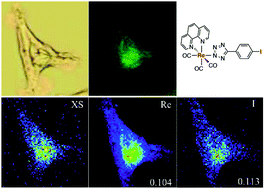Optical epifluorescence microscopy was used in conjunction with X-ray fluorescence imaging to monitor the stability and intracellular distribution of the luminescent rhenium(I) complex fac-[Re(CO)3(phen)L], where phen = 1,10-phenathroline and L = 5-(4-iodophenyl)tetrazolato, in 22Rv1 cells. The rhenium complex showed no signs of ancillary ligand dissociation, a conclusion based on data obtained via X-ray fluorescence imaging aligning iodine and rhenium distributions. A diffuse reticular localisation was detected for the complex in the nuclear/perinuclear region of cells, by either optical or X-ray fluorescence imaging techniques. X-ray fluorescence also showed that the rhenium complex disrupted the homeostasis of some biologically relevant elements, such as chlorine, potassium and zinc.
